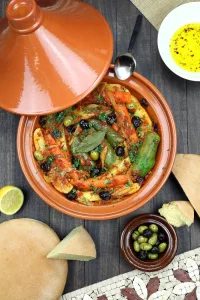Moroccan food or Moroccan cuisine is a rich and flavorful culinary tradition that reflects the country’s diverse history and cultural influences. It is characterized by a combination of Arab, Berber, Moorish, and Mediterranean flavors. Moroccan food is known for its aromatic spices, tender meats, couscous, and a wide array of fruits, nuts, and vegetables. Here are some of the traditional Moroccan food and dishes:
Tagines:
Moroccan tagines are not only a type of dish but also refer to the traditional cooking vessel in which the dish is prepared and served. The tagine is a clay or ceramic pot with a shallow, circular base and a cone-shaped lid that allows steam to circulate and condense, keeping the food moist and flavorful.
It is a popular and iconic cooking method in Moroccan cuisine. Tagines are mainly served as the main dish.
The most common ingredients used in Moroccan tagines include lamb, chicken, beef, or fish, combined with an assortment of vegetables, dried fruits, olives, nuts, and an array of aromatic spices. The key to a delicious Moroccan tagine lies in the skillful use of spices. Commonly used spices include cumin, coriander, paprika, ginger, saffron, turmeric, cinnamon, and cloves.
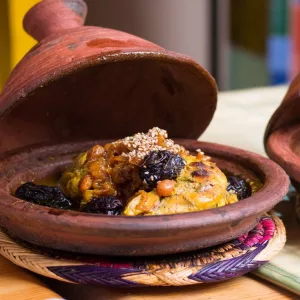
The combination of these spices creates a tantalizing and fragrant flavor profile. Tagines are not only a delicious and aromatic dish but also hold cultural significance in Moroccan cuisine. They are often enjoyed during festive occasions, family gatherings, and celebrations. Moroccan tagines are typically served family-style, with the tagine pot placed in the center of the table. The dish is often accompanied by couscous, rice, or bread, which can be used to soak up the flavorful sauce. Chopped fresh herbs and nuts may also be sprinkled on top as a garnish.
Also tagines have health benefits due to The slow-cooking method used in tagines helps preserve the nutrients in the ingredients, making it a healthy and wholesome way of preparing meals.
Couscous:
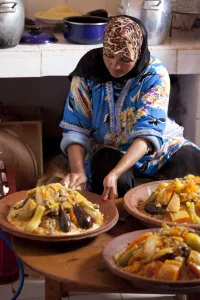 Moroccan couscous is very known as a traditional dish in the North of Africa that has popularity worldwide for its delicious flavors and versatility. It is a staple food in Morocco and is considered a significant part of the country’s culinary heritage. Couscous is believed to have originated in the Maghreb region of North Africa, which includes present-day Morocco, Algeria, Tunisia, and Libya. It has been a fundamental part of the local cuisine for centuries, and its exact origins can be traced back to the indigenous Berber people. The main ingredients of Moroccan couscous typically include durum wheat semolina (hard wheat), water, and salt. The semolina is moistened and rolled into small granules by hand until it forms tiny couscous grains. Additionally, couscous is often served with a variety of vegetables, meat, and/or legumes, depending on the region and personal preferences.
Moroccan couscous is very known as a traditional dish in the North of Africa that has popularity worldwide for its delicious flavors and versatility. It is a staple food in Morocco and is considered a significant part of the country’s culinary heritage. Couscous is believed to have originated in the Maghreb region of North Africa, which includes present-day Morocco, Algeria, Tunisia, and Libya. It has been a fundamental part of the local cuisine for centuries, and its exact origins can be traced back to the indigenous Berber people. The main ingredients of Moroccan couscous typically include durum wheat semolina (hard wheat), water, and salt. The semolina is moistened and rolled into small granules by hand until it forms tiny couscous grains. Additionally, couscous is often served with a variety of vegetables, meat, and/or legumes, depending on the region and personal preferences.
Preparing traditional Moroccan couscous is a time-consuming process and is often seen as a communal activity. The couscous grains are steamed several times in a special pot called a “couscoussier,” which consists of two parts: a bottom part for stewing the meat and vegetables and a perforated top part for steaming the couscous. 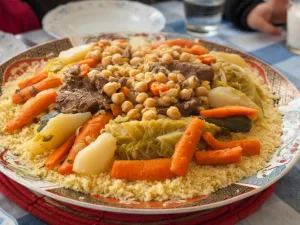 The couscous is steamed over the aromatic broth, which infuses it with delightful flavors.
The couscous is steamed over the aromatic broth, which infuses it with delightful flavors.
Couscous holds great cultural significance in Moroccan society. It is often served during special occasions, family gatherings, and religious festivals. In some Moroccan families, Friday is considered “couscous day,” and it’s a traditional dish prepared and enjoyed together. Even Moroccan couscous has gained popularity outside of Morocco and is now appreciated as a delicious and healthy option in many parts of the world. It is frequently served in Middle Eastern and North African restaurants internationally.
Pastilla:
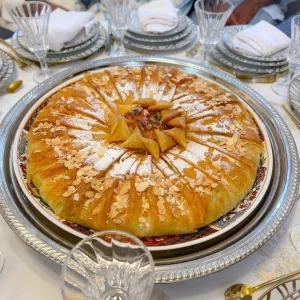 Moroccan pastilla, also known as “B’stilla” or “Bastilla,” is a savory and sweet traditional Moroccan food with a unique combination of flavors and textures. It is a delicacy that is often reserved for special occasions and celebrations. Pastilla is believed to have originated in Morocco and has its roots in Arab-Andalusian cuisine. The dish has been influenced by various cultures over centuries, including Berber, Arab, and Spanish, resulting in a unique and exquisite culinary creation. Pastilla is traditionally served on special occasions, such as weddings, religious holidays like Eid, and other important celebrations. Its preparation and presentation make it a dish associated with hospitality and generosity. The classic Moroccan pastilla is usually made with layers of thin, delicate pastry (similar to phyllo dough) known as “warqa” or “warka.” The filling traditionally consists of shredded poultry, such as chicken, pigeon, or sometimes seafood, mixed with a blend of aromatic spices, including cinnamon, saffron, ginger, and sometimes a touch of sugar.
Moroccan pastilla, also known as “B’stilla” or “Bastilla,” is a savory and sweet traditional Moroccan food with a unique combination of flavors and textures. It is a delicacy that is often reserved for special occasions and celebrations. Pastilla is believed to have originated in Morocco and has its roots in Arab-Andalusian cuisine. The dish has been influenced by various cultures over centuries, including Berber, Arab, and Spanish, resulting in a unique and exquisite culinary creation. Pastilla is traditionally served on special occasions, such as weddings, religious holidays like Eid, and other important celebrations. Its preparation and presentation make it a dish associated with hospitality and generosity. The classic Moroccan pastilla is usually made with layers of thin, delicate pastry (similar to phyllo dough) known as “warqa” or “warka.” The filling traditionally consists of shredded poultry, such as chicken, pigeon, or sometimes seafood, mixed with a blend of aromatic spices, including cinnamon, saffron, ginger, and sometimes a touch of sugar.
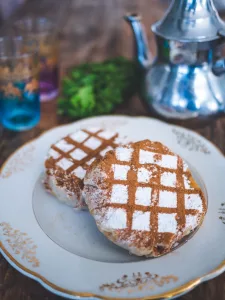
Other common ingredients in the filling include eggs, almonds, and caramelized onions. Some people us the powdered sugar and ground cinnamon to decorate the dish.
Making Moroccan pastilla is a labor-intensive process and is often considered an art form in Moroccan cuisine. The filling is cooked and spiced, then layered with the warqa pastry in a large, round, or square baking dish.
The pastry is carefully folded over the filling to create a neat package. The top is usually adorned with additional layers of warqa and then baked until golden and crisp. Just before serving, it is dusted with powdered sugar and cinnamon, which adds a unique contrast to the savory flavors. Pastilla is typically served as a main course, and it is often cut into portions and shared among several guests. It is not uncommon for the dish to be the centerpiece of a festive Moroccan meal.
Harira:
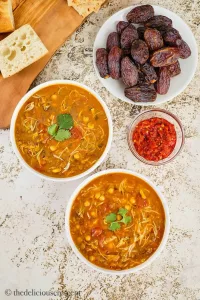 Harira is a traditional Moroccan soup that holds significant cultural and religious importance. It is a hearty and flavorful soup, typically enjoyed during the holy month of Ramadan to break the fast, but it is also served throughout the year on various occasions. Harira is not only a delicious soup but also a nourishing and satisfying dish.
Harira is a traditional Moroccan soup that holds significant cultural and religious importance. It is a hearty and flavorful soup, typically enjoyed during the holy month of Ramadan to break the fast, but it is also served throughout the year on various occasions. Harira is not only a delicious soup but also a nourishing and satisfying dish.
Harira is not just a soup in Moroccan cuisine; it is a symbol of unity, tradition, and hospitality, deeply ingrained in the country’s cultural fabric.The exact ingredients of Harira may vary slightly based on personal preferences and regional differences, but the core ingredients typically include:Tomatoes, Harira is tomato-based, and ripe tomatoes are often used to create a rich and savory broth. Lentils and Chickpeas, These legumes provide protein and thickness to the soup.Meat, Harira contains lamb or beef, which adds a depth of flavor to the soup. However, there are also vegetarian versions that omit the meat. Vegetables, that mainly are Onions, celery, and parsley are commonly used to enhance the soup’s taste and texture.
Moroccan Harira also can not be delicious without a blend of spices, including ginger, turmeric, cinnamon, and saffron, gives Harira its distinct Moroccan flavor profile. Also some Herbs that are optional for example Fresh cilantro and parsley are often added just before serving to add a burst of freshness.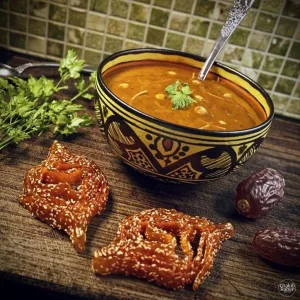
Thin noodles or vermicelli are added to the soup, making it heartier and more filling. Flour is used as a thickening agent to achieve the desired consistency. The preparation of Harira involves slow-cooking the ingredients together to allow the flavors to meld. The process often starts with sautéing onions, meat, and spices, followed by adding tomatoes, lentils, chickpeas, and water. The soup is then simmered until the meat is tender and the flavors are well developed. Towards the end of cooking, vermicelli is added to thicken the soup further. Fresh herbs are sprinkled over the soup just before serving, adding a vibrant touch. During the month of Ramadan, Muslims fast from sunrise to sunset, and the fast is broken at Iftar (the evening meal) with dates and a bowl of Harira.
It is a traditional and symbolic way to break the fast, as the nourishing soup provides the body with essential nutrients after a day of fasting.
While the basic ingredients remain constant, there are numerous regional and individual variations of Harira. Some recipes may include rice, barley, or different types of meat, while others may include additional vegetables or spices.
Baghrir:
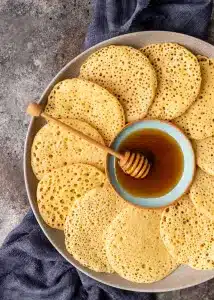 Baghrir, also known as “Moroccan pancakes” or “Thousand-Hole Pancakes,” is a popular and unique Moroccan food. These spongy and light pancakes have a distinctive appearance with a multitude of tiny holes on the surface, which is created during the cooking process. Baghrir is a beloved breakfast or snack item in Morocco, often served with honey or syrup. The main ingredients used to make Baghrir include:
Baghrir, also known as “Moroccan pancakes” or “Thousand-Hole Pancakes,” is a popular and unique Moroccan food. These spongy and light pancakes have a distinctive appearance with a multitude of tiny holes on the surface, which is created during the cooking process. Baghrir is a beloved breakfast or snack item in Morocco, often served with honey or syrup. The main ingredients used to make Baghrir include:
Semolina: Baghrir is made with fine semolina flour, which gives the pancakes their characteristic texture and structure.
All-Purpose Flour: All-purpose flour is also used to enhance the texture and fluffiness of the pancakes.
Yeast: Yeast is used as a leavening agent, which helps the pancakes rise and create the unique porous texture.
Water: Water is used to form the batter, and it is essential to achieving the right consistency.
Salt: A pinch of salt is added to enhance the flavor.
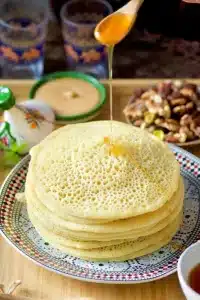
The preparation of Baghrir involves creating a thin pancake batter and then letting it rest for some time to allow the yeast to activate. As the batter rests, bubbles form, leading to the characteristic holes on the pancake’s surface during cooking.
Baghrir is typically served warm and drizzled with honey, date syrup, or a mix of butter and honey. Some people also enjoy them with a spread of jam or Nutella.
Baghrir is a beloved dish in Moroccan food, enjoyed by people of all ages. It is commonly served during the holy month of Ramadan for Iftar (breaking the fast) due to its light and satisfying nature.
While the basic Baghrir recipe remains relatively consistent, some variations may include the addition of orange blossom water or yeast alternatives, such as baking powder, for those who prefer not to use yeast.
The Best Restaurants in Marrakech
| Name | Location | Highlights |
|---|---|---|
| Restaurant Fluffy Marrakech | Arsat Maach, 91 Avenue Hommane Fetouaki, Marrakech 40000 | A place where you can enjoy both the Moroccan food and the fast food. |
| Resaurant Lao Marrakech | Enhafsa 14 rue oued al makhazine et Place du 16 novembre, Guéliz, Marrakech | Offers a warm and charm hospitality beside yummy dishes. |
| Restaurant Dar Essalam Marrakech | Dar Essalam, 170 Riad Zitoun Kedim, Marrakech 40000 | A luxurious restaurant with tasty dishes while enjoy some shows. |
The Best Restaurants in Fes.
| Name | Location | Highlights |
|---|---|---|
| Restaurant Lamandier au Palais faraj | Palais Faraj, Bab Ziat Medina de Fes. | Immerse yourself in the vibrant flavors of Moroccan food in this charming restaurant with ana amazing view from the terrace. |
| Restaurant Palais Bab Sahra Fes | 25 Derb Tariana Talaa Lakbira fes maroc 300. | Features traditional Moroccan food and offers various tradional music. |
| Cinema Cafe Fes |
8 Sid Lkhayat Batha, Fes 30110 Morocco.
|
A small but stunning restaurant and easy location to find. |
The Best Restaurants in Casablanca
| Name | Location | Highlights |
|---|---|---|
| Rick’s Cafe | 248, Bd Sour Jdid, 20110, Casablanca | The restaurant that made most of the tourists know about Casablanca. |
| Solamo’s Cafe Casablanca | Bd d’El Hank, Casablanca, Grand Casablanca, Maroc | Small and amazing restaurant to have your meal and close to Hassan II Mosque. |
| Restaurant Dar El Kaid | Rue Mohamed El Alaoui Ex Rue des Synagogues, Casablanca |
A place that mixes between the luxurious design and the traditional food. |
The Best Restaurants in Rabat.
| Name | Location | Highlights |
|---|---|---|
| Restaurant Dar Naji Rabat | Rue Jazirat Al Arab Bab Al Had, Rabat 11000,Morocco. | A place where you feel you are in a real traditional Moroccan restaurant. |
| Marina Palms Restaurant | 3 Av. Al Marsa, Rabat 10050 | A perfect option for seafood lovers with a view to the river. |
| Restaurant Dar Zaki Rabat |
23, Rue Moulay Brahim Ancienne Medina, Rabat 10000 Morocco
|
Known for its tradional Moroccan tasty dishes. |
FAQ
Are there vegetarian options available in the Moroccan restaurants ?
If you are a vegetarian person, that will not be a problem for you because there are several vegan options. Even in many cities you find vegan restaurants, which facilitate it for the vegan people. And these multiple options highlight the variety and adaptability of Moroccan food, making it simple for vegans and vegetarians to savor Moroccan flavors and learn about the country’s culinary history.
What is the most typical breakfast served in Morocco ?
A delicious mix of both savory and sweet treats makes up a typical Moroccan breakfast. Breads like khobz, baghrir, msemen, and rghaif are served with spreads like olive oil, honey, or jam. Dairy foods like yogurt and soft cheese go well with these breads, and pickled veggies and olives give a savory flavor. Eggs cooked in a variety of ways—from scrambled to boiled—provide options high in protein, and pastries like chebakia and sfenj give a sweet treat. The dinner is finished with the traditional Moroccan mint tea, which is a fragrant and sweetened green tea steeped with fresh mint leaves. Fresh fruit, such as oranges, dates, and figs, provides a refreshing flavor. Breakfast is made to be leisurely and delicious with this blend of flavors and textures.
How do Moroccans prepare the mint tea ?
Most of the tourists when they hear about the Moroccan mint tea think it is only hot water and mint. However, the main essential ingredient is green tea and actually the mint is just to add a flavor. That is why you find people who put other herbs instead of the mint. So the method is start boiling the water then you put the green tea until it is cooked then you put the mint or any herbal tea you have.
What are some Moroccan drinks ?
Without doubt the most common Moroccan drink is the Tea, especially the mint one. That refers to Moroccan hospitality. As wherever you go you get welcomed by a cup of tea. Not only for tourists but in Moroccan daily lives as well. Also, fresh orange juice is very common in Morocco especially in summer time when the climate is very hot you can get a cold fresh orange juice. Morocco is known also for some other juices like sugar cane juice, pomegranate juice and many others.
Do Moroccan restaurants serve Alcohol ?
Despite Morocco being a Muslim country and in Islam all kinds of alcohol drinks are prohibited for all muslims. However, there are many restaurants that serve Alcohol for their guests during the meal. Also there are places where you can get alcohol drinks on your own and drink them while having your meal. In Ramadan there will be less options for places that serve alcohol but still there are some places that serve them in Ramadan especially in Marrakech.
What are some not famous dishes in Morocco?
Some Moroccan dishes like Tagines, couscous, soup are very famous all over the world. But, there are other tasty dishes that are not famous and are not published. One of them is the Berber pizza or called Madfouna. It is a special dish in the Sahara desert in the south east of Morocco. It is a special dish for the Nomads and you cook it underground. It is made of flour and inside they fill it with onion, carot, meat, almond, eags and spices. After finishing the preparation they cover it with the axe to cook in slow fire. Also Michwi or Moroccan barbecue is one of the tasty foods that is not famous but you should try it. Other not famous dishes are Bissara, Tanjiya, Rfissa, and many others. .
Are there any regional specialties I should try in different parts of Morocco?
Generally speaking Morocco is famous for many dishes like Couscous, Tagines, Soup, Pastilla and others. However, each part of Morocco is known for some special dishes. For example, Fes is very known for Pastilla, which is one of the tasty dishes you should try while you are in Morocco, especially if you are visiting Fes. Marrakech is known for a special dish called Tanjiya that is made of beef or lamb. The south east of Morocco for example is known for a dish called Madfouna or the Berber pizza. The north part of Morocco is known for a type of soup called Bissara that is made of Beans.
Are Restaurants open during Ramadan?
Since all Moroccans fast during the month of Ramadan all the day, tourists think that the restaurants are closed during the day. But there are many restaurants that serve food during the whole month of Ramadan. If you are travelling to Morocco during Ramadan just bear in mind that will not affect your trip because the vibes are still the same in Ramadan as well. there may be some missing things but still you can enjoy your trip.
Are there any activities to do related to the Moroccan cuisine?
One of the activities that the food lovers can do while visiting Morocco is a Moroccan cooking class. This activity will allow you to be more close to Moroccan cuisine with its secrets. You will have a deep knowledge about the hidden secrets behind Moroccan food with an expert cook. During this activity you will have the chance to ask questions , and techniques about the recipes.
How do we prepare a Moroccan tagine?
Tagine is one of the most famous dishes in Morocco. Everyone who went to Morocco had a tagine. Tagine is 100 percent Moroccan dishe, which the locals have also for their meals. The method to prepare can be different from cook to cook. But we will mention the most common way to prepare a Moroccan tagine with vegetables and meat or chicken. The vegetables needed are Onion, potato, tomato, carot, zucchini, garlic, pepper, and coriander. However, if you are missing one or two of these vegetables it is still okay to prepare your tagine. The first step is to bring your Tagine and put the onion first with some oil, spices and garlic. Second, put the meat or chicken you have, if you are vegetarian you can cook it without any meat. Third you start putting the other vegetables you have and better to put the vegetables that need more time to cook first. Then you add more oil, spices, and some coriander. Finally put your tagine in a slow fire and give it about one hour of cooking but you keep verifying it from time to time not to burn.

